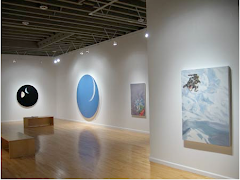Not for Sale
Curated by Alanna Heiss
at PS1
NYC
Call it the Benjamin effect, but I’ve never felt that The Mona Lisa was a particularly interesting painting. The stories that surround it, however, are of course wildly captivating. My favorite of these stories revolves around the fact that Leonardo kept the work until his death. He took it with him wherever he traveled. In a lifetime of acclaim and commissions, this one was for him. It was his. The Mona Lisa was not for sale. I think that this is something that all artists can relate to. Works come and go. Things are bought and sold, lost and destroyed. Putting together a slide package is like flipping through a photo album dedicated to former lovers. Most of them make you cringe. Some of them make you proud. Then there’s the one that you held onto a little bit longer than the rest.
The curatorial premise of the current exhibition at P.S.1 is clearly embodied in its title, “Not for Sale”. It features an impressive collection of works by an impressive collection of artists. As an added bonus, most of the works are accompanied by a short explanatory statement that describes the artists relationship to that work. These rationales are as varied as the works. There are three framed Peter Halley drawings from 1980 that clumpily but implicitly depict prison cells. Halley has kept them because they were the first sketches that dealt with what would later become his major work. Looking at them, you can almost feel the light bulb going on. A work by Richard Prince from 2004 titled “Untitled Publicity” entails a glamorous and glossy Nicole Kidman headshot that she has signed “To Richard. Love Nicole.” There is an uncashed cheque written out to Prince from Paramount Pictures that is also mounted in the frame. Prince had rented some works for Paramount’s remake of The Stepford Wives. The piece is touching in a dorky-but-honest-sort-of-way. After all, even art stars get star-struck. There is a whole room of Richard Tuttles that are characteristically Tuttle-ian (ie. small and awkward and beautiful and weird.) These works, however, are the only works in the show that are not “courtesy of the artist”. They have been provided by Tuttles wife the poet Mei-Mei Berssenbrugge. Matthew Ritchie’s stunning 2003 triptych-on-paper 5 of a kind is a baroque explosion of washed blues and mudded browns with jutting streamers of lemon yellow and faded ochre. As part of his personal history of the universe, these works characteristically create a map of a self-reflexive, semiotic evolution. Yet he made this piece while his wife was pregnant, and so it came to deal with another sort of evolution as well. He is keeping the piece for his son.
Not all of the works are successful. Not all of the stories are interesting. Alex Katz’s 2005 portrait Kate has (allegedly) been kept because it fits in well with his condominium décor. Dana Schutz’s portrait of her husband is second year undergrad material. It’s one- layer-thick, get-it-right-the-first-time and random-colours-while-wearing-a-blind-fold sensibility are cliché and trite. And although her supporters would say that this is the point, it’s a point I’m tremendously tired of seeing. Jeff Koons Popeye of 2003 is an incredibly slick yet utterly vacuous re-visitation of Rosenquist-minus-the-masking-tape-style pop. His “assistants”, however, really are quite talented. Julian Schnabel’s monolithic-elegiac Cortes of 1988 is a nice piece but can’t live up to the loftiness of its placard. Schnabel describes the work as representing “the fundamentals of being.” (Personally, I find it difficult to connect his use of ripped burlap to a sense of ontological stability.)
The best of the bunch, however, belongs to Eric Fischl. It is a modestly scaled and untitled work from 2001. A female nude reclines on a bed. Her hand rests between her opened thighs in a gesture that neither conceals nor invites. She slips back into the darkness of deeply layered browns and blues that drip and wash and matte and shine. Looking back into these painterly shadows, her gaze is concealed. The creamy pinks of her body meander into lush loose strokes of refined confidence. There is a dignity here. This painting speaks with a frankness and candor that is neither contentious nor provocative. It is disarming in its honesty. His statement reveals a similar candor that to my mind, encapsulates the sentiments that the best of the works in this show demonstrate:
“Every once in a while, I make a work that reveals (to myself) a tenderness, a simple expression of love that I did not thing I was capable of making. When this occurs, I am in no rush to bring the lamb to market.”
As a Canadian artist it is easy to target the American art market and its continuous carousal of self-righteous-self-importance. History, after all, would seemingly lie in the balance of its cheque books. The “Not for Sale” show manages, despite the grandeur of its own celebrity, to touch on the core of art production. There is a gooey centre here beneath the hardened candy. Even Jeff Koons has his Mona Lisa’s.

video footage from Sudden Frost at Elissa Cristall, Vancouver
Will Gorlitz at Michael Gibson Gallery

John Eisler at Diaz Contemporary

Michel Daigneault at AKAU

No comments:
Post a Comment